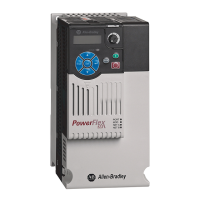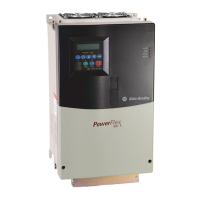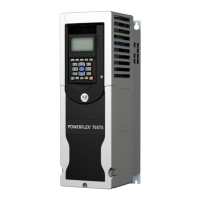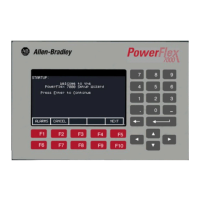Rockwell Automation Publication 520-UM001A-EN-E - February 2013 187
Appendix E
Encoder/Pulse Train Usage and Position
StepLogic Application
Encoder and Pulse Train
Usage
The PowerFlex 525 drive includes a pulse train input built into the terminal
block, and an encoder option card. The pulse train and encoder can be used for
many of the same functions, but the pulse train supports up to 100 kHz at 24V,
and uses the drive built-in terminal block. The encoder supports up to 250 kHz
dual channel at 5, 12 or 24V and requires the optional encoder board to be
installed. When A535
[Motor Fdbk Type] is set to a value other than zero, the
drive is set to use an encoder or pulse train. The drive will use the encoder or
pulse train in several ways depending on the settings of other parameters. The
drive will use the encoder or pulse train as shown below (listed in order of
priority):
1. If enabled by P047
[Speed Reference1], the encoder or pulse train will be
used directly as a commanded speed (normally used with a pulse train) or
as a position reference (normally used with a quadrature encoder).
2. If not enabled by P047
[Speed Reference1], when the PID Feedback or
PID Reference are set to use an encoder then the PID function will use the
encoder or pulse train input.
3. If not enabled by P047
[Speed Reference1] or the PID parameters, then if
A535
[Motor Fdbk Type] is set the encoder or pulse train is used for direct
feedback and trim of the speed command. The normal slip compensation
is not used in this case. Instead the drive will use the encoder or pulse train
to determine actual output frequency and adjust the output frequency to
match the command. Parameters A538
[Ki Speed Loop] and A539 [Kp
Speed Loop] are used in this control loop. The primary benefit of this
mode is increased speed accuracy when compared to open-loop slip
compensation. It does not provide speed bandwidth improvement.
Encoder Interface
The incremental encoder option card can source 5 or 12 volt power and accept 5,
12 or 24 volt single ended or differential inputs. See Appendix B
for ordering
information.
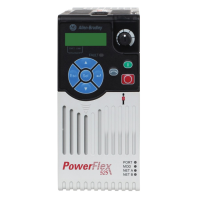
